JUMP TO
Cheap, delicious and nutritious, this sour cabbage stew is one of those traditional recipes found in all Eastern European cuisines. It’s absolutely delicious, easy to make, and has very special sweet, sour and salty taste that you won’t find anywhere else.
Growing up in Romania, my mother used to cook this type of cabbage stew all the time during winter. This recipe is called varza calita in the Romanian language and it’s traditionally prepared using meat as one of the main ingredients. Since this is a vegan recipe, we won’t be using any kind of meats but I promise you that our vegan cabbage stew will turn out even better.
I think you guys are going to LOVE this sour cabbage stew. It’s:
Sweet
Salty
Sour
Delicious
Super Healthy
Satisfying
Savory
Vegan
Hearty
Are you ready to cook the best stew ever? Let’s get started!
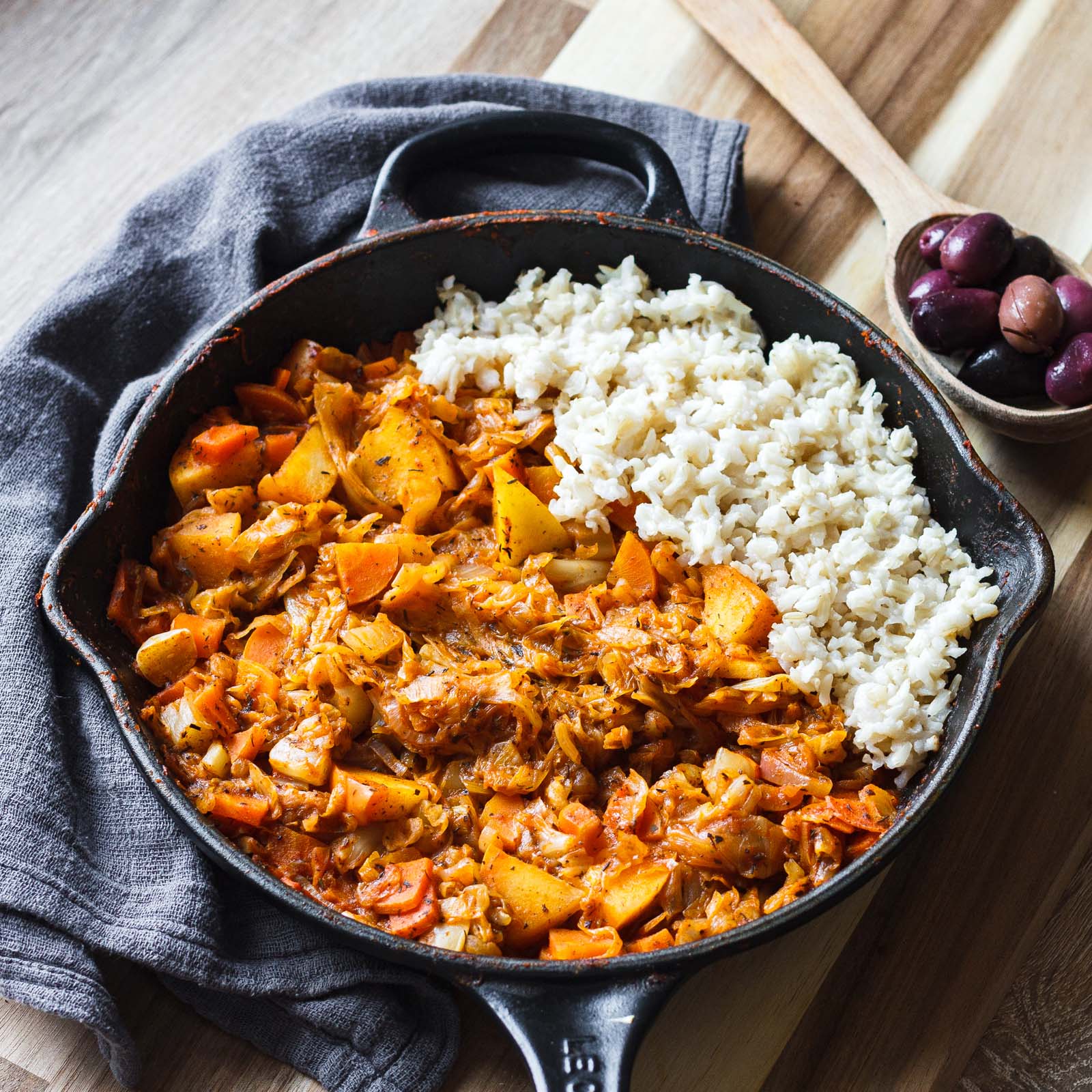
What is sour cabbage?
The main ingredients that we’ll be using for our sour cabbage stew is … SOUR CABBAGE!
Sour cabbage is a fermented vegetable food preserve popular in Eastern-European cuisine, similar to sauerkraut but with a small difference. As its name says, whole sour cabbage is prepared through the lacto-fermentation of whole heads of cabbage for several weeks.
Sour cabbage is a homemade food preserve, commonly prepared in large barrels filled with whole cabbage heads, water and salt. In contrast, sauerkraut is prepared from separated leaves of cabbage, which gives it a slightly different taste and a totally different texture.
In case you don’t have sour cabbage (or maybe you don’t like it) but still want to make this cabbage stew, don’t worry because you can also use fresh cabbage (aka sweet cabbage) plus a small “hack” to make the stew sour-ish at the time of cooking.
Ingredients List
In a nutshell, these are the ingredients that you’ll be needing for cooking this sour cabbage stew:
- whole sour cabbage (as an alternative use fresh white cabbage)
- shallots
- fennel
- carrots
- celery root
- extra virgin coconut oil
- apple (optional)
- dried thyme (important!)
- dried dill
- basil leaves (optional)
- garlic cloves
- Himalayan salt (or your favorite salt)
- white or black pepper
- sweet paprika or tomato paste
- water
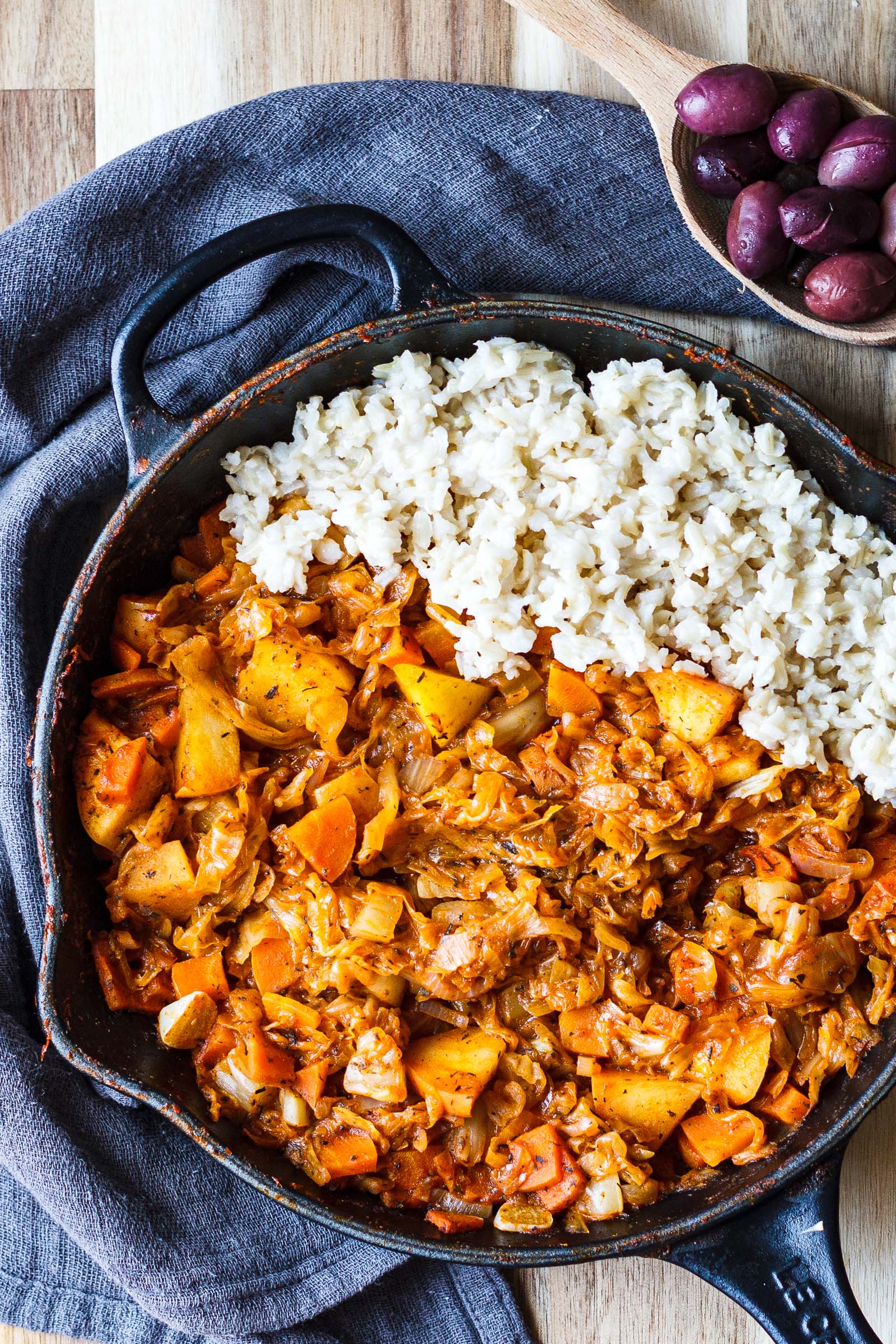
How to cook this delicious sour cabbage stew
The most important part of making sour cabbage stew is to have access to the main ingredient, whole sour cabbage. In case you don’t have sour cabbage, you can simply use fresh cabbage instead. You must know that using fresh cabbage won’t produce the same sour-ish taste of the traditional recipe, simply because fresh cabbage is sweet (not sour).
Rest assured, follow my recipe and your stew will turn our amazing either way. I’ve put together a small “hack” to help you obtain that special sweet and sour taste by using fresh cabbage (… and something extra). More info later on!
Here’s a quick overview of the main steps to follow when cooking this stewed cabbage (as always, find complete instructions in the recipe card!):
- Start by chopping the cabbage and add it to a cast iron pan (or a big pot) along with the other vegetables. Also add the extra virgin coconut oil or extra virgin olive oil.
- Cook over medium heat, making sure to add more water if needed. Mix from time to time using a spatula making sure that the cabbage won’t stick to the skillet.
- Once the cabbage starts to reduce in size and becomes soft, add spices and salt. Now it’s a good time to add either sweet paprika or tomato paste. Incorporate everything slowly using a spatula.
- Cook for a few more minutes until most of the water has evaporated. Taste it to make sure the cabbage is cooked-soft and that it has enough salt.
- Ta-Daa! Your cabbage stew is ready now.
(More detailed instructions are below).
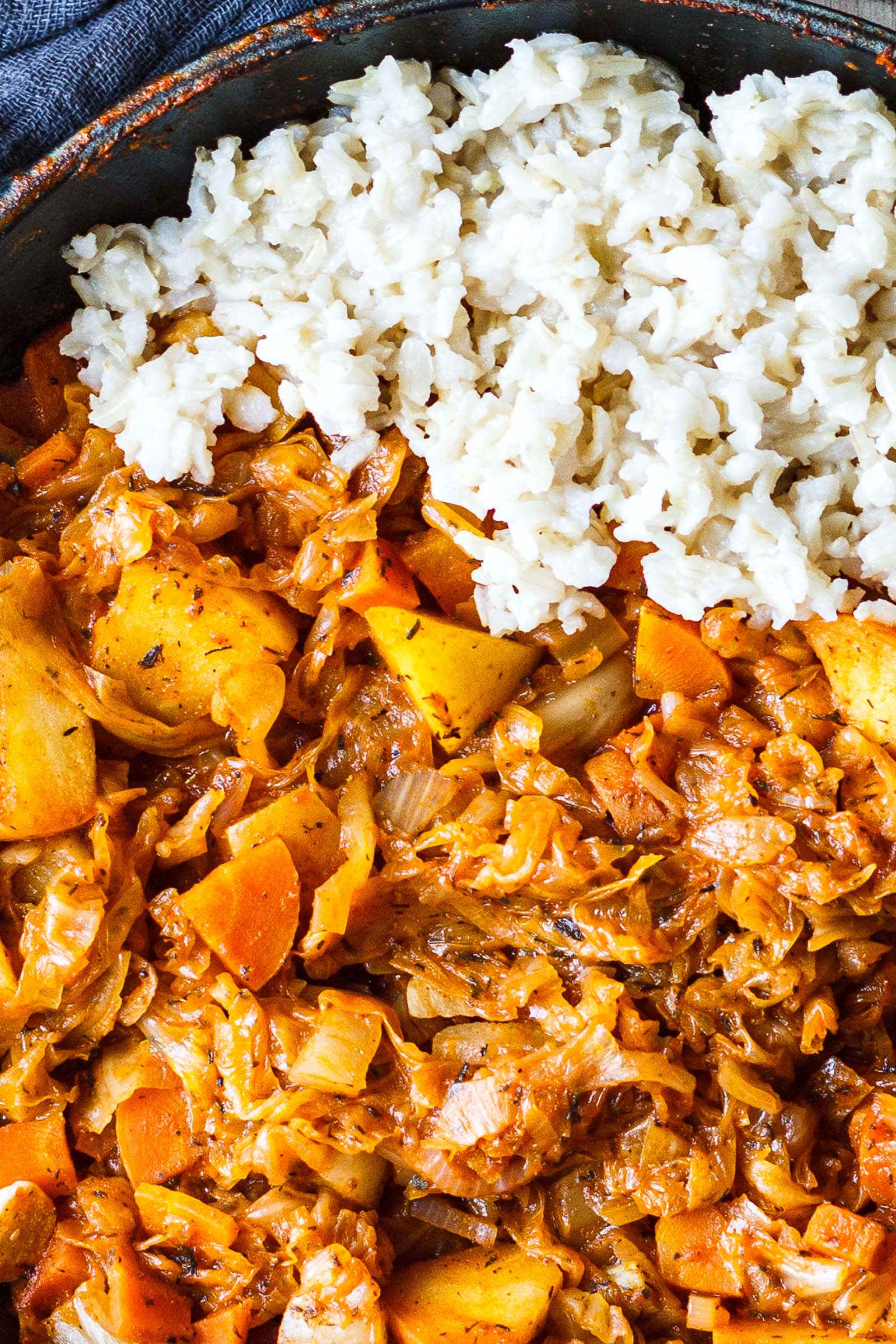
Cooking Tips
Measuring the ingredients. This recipe is so versatile and forgiving that we don’t have to measure everything to the gram. My suggestion is to taste it while it’s cooking and to use your taste buds (and intuition) as a guide to cooking the stew that you want to eat.
How much water to use? There’s no rule when it comes to the quantity of water that you should use. Add as much water as you need in order to cook everything nicely into a stew (depends on the quantity of cabbage and how big your cooking pot is). The water evaporates while cooking so it’s safe to say that you won’t end-up with something like a soup instead of a stew.
Sour of Sweet Cabbage? I case you don’t have access to sour cabbage you can successfully use fresh cabbage instead (also called sweet cabbage).
If you plan on using fresh cabbage there are a few things that you’ll have to adjust for:
- It takes a longer time to prep the cabbage – since fresh cabbage has a firmer texture compared to the soft texture of sour cabbage, it’ll take you a bit longer to chop it (and a bit more skill if I may say so).
- It takes a bit longer to cook it – the cooking time will double due to the same reason above (mainly fresh cabbage having a firmer texture).
- Use more water – since the cooking time will increase, you will definitely have to add more water as it evaporates.
How about the sour taste with fresh cabbage? In case you decide to use fresh cabbage instead of sour cabbage, know that you won’t end-up with that same “traditional” sour taste. Instead, this stew will have a rather sweet-ish taste. In order to obtain something close to the traditional sour taste, add the juice from 1/2 small lemon or from 1 small lime towards the end of the cooking process.
Is thyme important? To tell you the truth, thyme in a crucial condiment of this cabbage stew because it balances perfectly the sour taste of the cabbage.
I don’t want to use coconut oil. We’re using coconut oil as a way to allow the vegetables to cook without sticking but also because we want to add healthy fats to this vegetable-based meal. You can also butter if you like it better, and even extra virgin olive oil works great.
Sweet paprika or Tomato Paste? We use either one to add a pale red color (and a special flavor) to our cabbage stew. It’s ok to skip them both if that’s what you want but know that your stew will end-up with a pale white color (and boring looking :P).
What if I don’t like or don’t have rice? You can obviously serve this meal without rice or you can prepare the rice the way you like it. I only provided the boiled rice as a suggested way of serving this sour cabbage stew (rice instead of bread, for example).
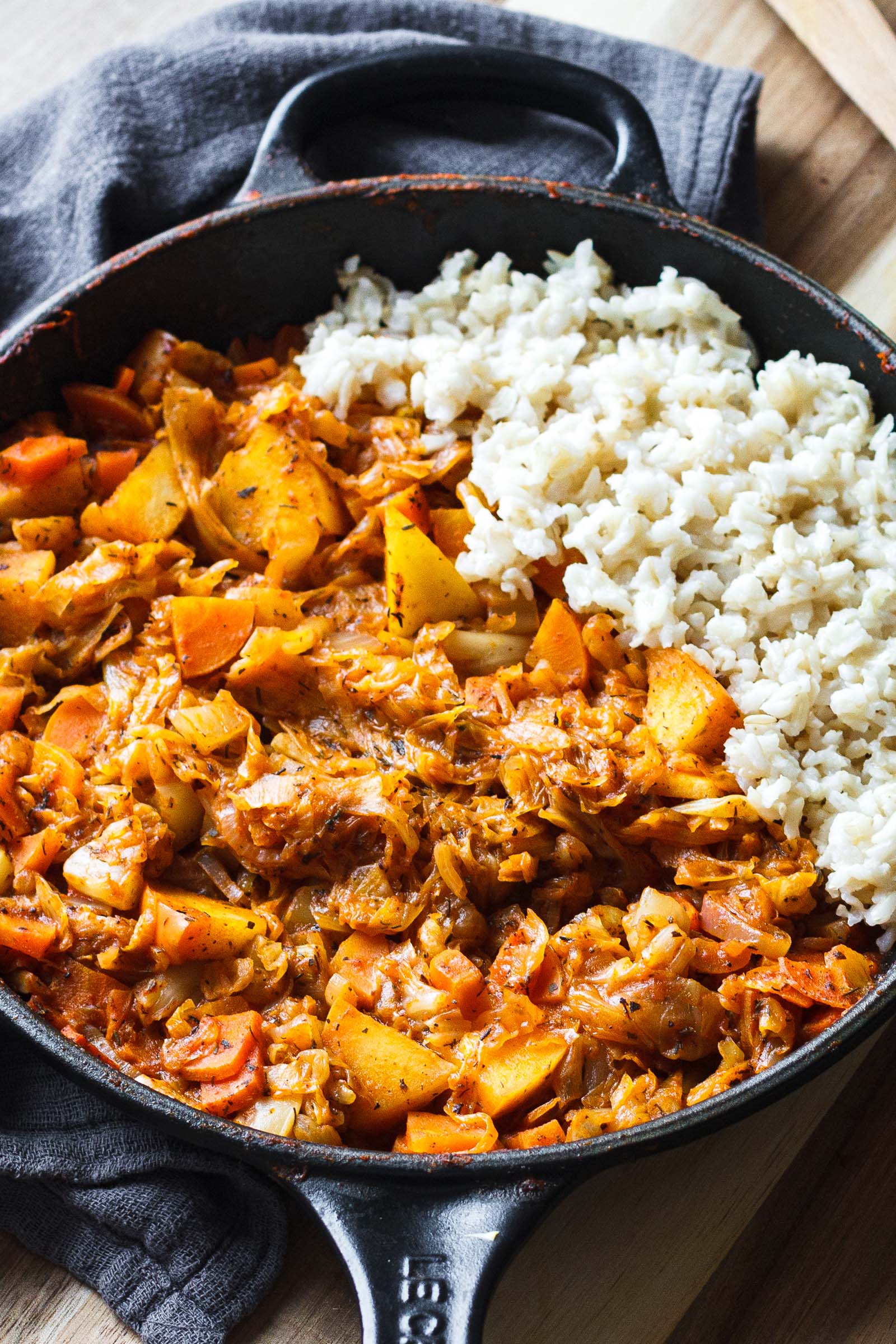
How to serve this sour cabbage stew
- Serve it as I did – with a side of freshly cooked Basmati or Jasmin rice (recipe below).
- Serve it traditionally – with freshly baked bread and raw onion (scallions or slices of classic onion).
- With a slice of your favorite bread – to tell you the truth, any bread works with this stew, sourdough bread, Danish rugbrød and Drench baguette being all excellent choices.
- Include a source of healthy fats – kalamata olives are great, so are walnuts or pecans, and even 1-2 tablespoons of sour cream.
- You can pair this cabbage stew with cheese – both hard and soft cheese are great choices and match perfect with this sour cabbage stew. Soft cheese like brie, munster, or vosges are among my favorites. When it comes to hard cheeses, I prefer emmentaler, gouda, aged cheddar or comté. In Romania, we serve it with the traditional white sheep’s cheese.
What do you think about this sour cabbage stew? Give it a try and let me know if you like it.
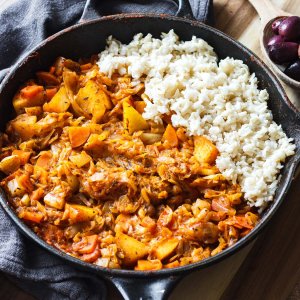
Traditional Sour Cabbage Stew (Vegan)
Equipment
- Skillet or Cooking Pot
Ingredients
Sour Cabbage
- 1/2 medium sour cabbage (about 500 g, alternatively use fresh white cabbage)
- 3 shallots (peeled and sliced)
- 1 big slice fennel (chopped)
- 3 carrots (cubed)
- 1 slice medium celery root (1/3 cup, peeled and cubed)
- 1 big tbsp extra virgin coconut oil (or 2-3 tbsp of extra virgin olive oil)
- 1 big apple (no seeds, sliced)
- 2 tsp dried thyme
- 2 tsp dried dill
- a few basil leaves (optional)
- 3 cloves garlic (chopped)
- 1-2 tsp Himalayan salt
- 1-2 tsp white or black pepper
- 2 tsp sweet paprika (or 4 tsp tomato paste 22%)
- water (as needed)
Rice
- 125 g Basmati rice (or Jasmin rice)
- water (as needed)
- 1 tsp Himalayan salt
Instructions
How to Cook the Cabbage
- Chop the cabbage (not very fine) and add it to a cast iron pan or a big pot.
- Prepare all the other vegetables as indicated in the parentheses and add them into the same cooking pot.
- Also add extra virgin coconut oil (or extra virgin olive oil).
- You can add the apple now or you can add it later, towards the end of the cooking process.
- Cook over medium heat, making sure to add more water if needed. Mix from time to time using a spatula, making sure the cabbage won’t stick to the skillet (this is important!).
- Once the cabbage starts to reduce in size and becomes soft, add spices and salt. Now it’s a good time to add either sweet paprika or tomato paste. Incorporate them slowly using a spatula.
- If you haven’t added the apple slices yet, this is the time to throw it in.
- Cook a for a few more minutes just to make sure that most of the water has evaporated. Taste the cabbage to see if it’s cooked-soft and that it has enough salt.
- Ta-Daa! Your cabbage stew is ready now. Serve with your favorite extras and enjoy the traditional Easter-European aromas.
How to Cook the Rice
- Add rice to a pot and cover with water.
- Cook on small to medium heat until the rice expands. Do not boil the water as that is not a smart way to cook rice.
- Use a wooden spatula to mix the rice from time to time, making sure it won’t stick to the pot. Add more water if needed and supervise the cooking process (won’t take more than 20 minutes).
- Once the rice expands, taste it to make sure that it’s almost done. If not, continue to simmer on medium heat (do not boil the water).
- You’ll notice that the water will start to become less and less, which means the rice expands more and more.
- When the rice is cooked (taste it first to be sure) remove from heat and set aside for a minute.
- Add salt and incorporate using a spatula.
- Leave it covered for a minute to allow the rice to finish absorbing the water, which in turn will make it more tender and soft.
- Strain the water and … That Is It !
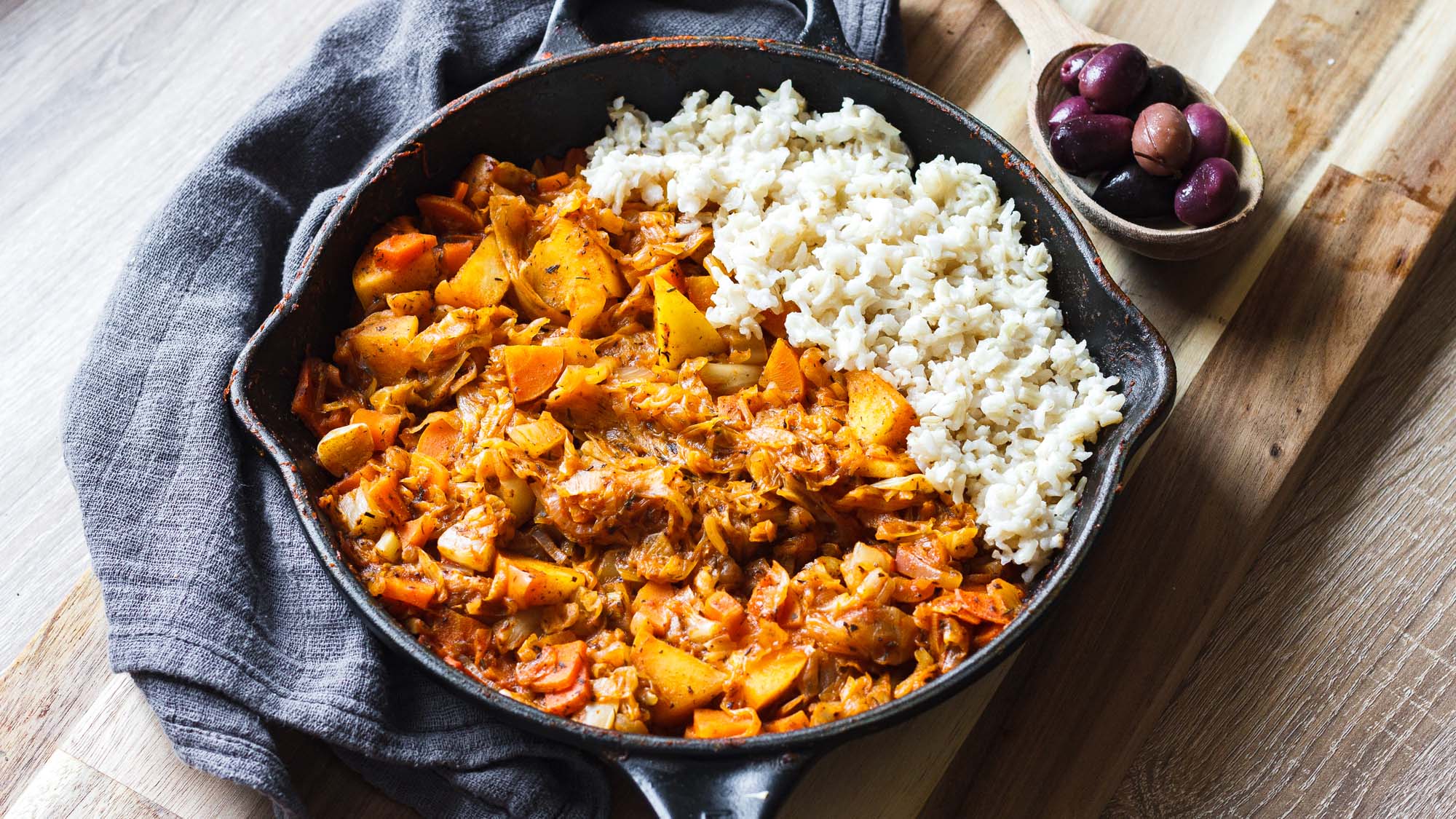

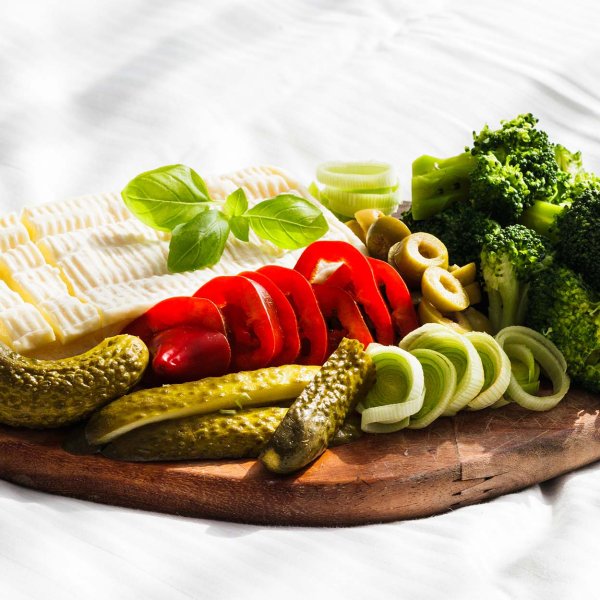


















I simply love sour cabbage stew but never made it as a vegan recipe. I will try your recipe!
This looks fantastic and I love it that it’s vegan.
Never made sour cabbage before but it’s on my list for this week-end.
Fingers crossed ….
Hi Kristine,
It is a special dish that I hope you will love.
Let me know how it turned out for you,
Love,
Marcel
What a delicious way to cook cabbage! I’m definitely looking forward to see how it turns out.
I hope it’s as good as the pictures show it 🙂 kidding!